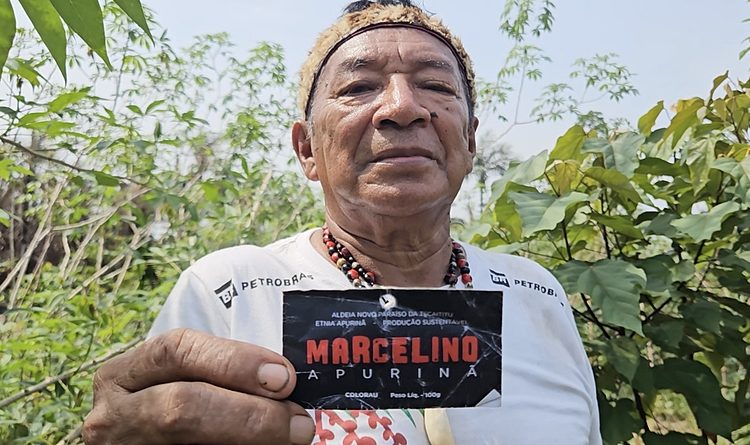Not even the intense sun of the Amazon prevents Marcelino Apurinã, 73, from making daily inspections in his Agroflorestal System (SAF, in Portuguese). SAF is a planting technique that intertwines, in the same space, native species with food cultivation free from pesticides and in a sustainable way.
“SAF is a model we make today without the environment. It’s established in areas where trees have already been cut down. Here, we have a diversity of plants. It isn't a monoculture," Marcelino Apurinã proudly says.
The union between the Amazonian Forest and the region’s typical food is good for the environment and helps to recover deforested areas. Up until now, Marcelino and his family have reforested 120,000 square meters.
The reforestation actions couldn’t have happened at a better moment, since Marcelino’s SAF is in Lábrea, Amazonas state, in the so-called deforestation arc, the term used to refer to the region where the forest is burning at a faster pace than in any other area of the biome.
“We are helping nature. Today, we plant açaí [a typical fruit of the Amazon region], pineapple, babaçu, tucumã… In the same areas, we also plant cassava to make flour. Amazonian people cannot live without cassava flour,” says Apurinã while laughing.
From slavery to paradise: an Apurinã story
It all happens in Novo Paraíso (“New Paradise”, in English) Indigenous community, inside the Caititu Indigenous Land, Amazonas state. However, to achieve it, Marcelino Apurinã had to face dark moments and survive colonial violence against Indigenous people living in the southern area of Amazonas state.
“Our community was exterminated by the patrão [“boss”, a way to refer to economically powerful men]. My grandparent was the only one who survived. He was raised by patrão. After that, he worked for patrão, but had an altercation with him and then ran away. We were expelled from there. They took all our land”, the Indigenous man recalls.
Back then, those who controlled things were the so-called “patrões da borracha” (“latex bosses”), the owners who exploited enslaved Indigenous people to produce latex, which supplied the US arms industry during the Second World War.
“Of all the suffering, the worst was the fact that there were killers of Indigenous people. They ran after them and burned down their houses. Patrões and seringalistas [men who extract latex] controlled everything and killed a lot of Indigenous persons. They almost killed us all,” says Marcelino.
To run away from the rubber plantation, he traveled the Purus River for four days by canoe. He arrived at the urban area of Lábrea, in Amazonas state, where the Caititu Indigenous Land had been recently recognized as such by the Brazilian state. There, he found a place for him, which became the Novo Paraíso Indigenous community, Marcelino’s and his family’s home.
A forest that heals and feeds
Maria dos Anjos Nogueira, Marcelino’s wife for 50 years, has an extensive medicinal garden at the back of the small house where she lives with her husband.
“There are teas aimed at stroke, the blood circulatory system, blocked veins and even malaria," she says.
It is difficult not to find a disease for which Maria has no remedy in her garden. An Apurinã person herself, at a young age, she started learning that the forest is also a pharmacy. The ancestral knowledge is a heritage from when Indigenous health wasn’t yet a public policy in Brazil.
“I cannot live without these plants because they are a high-value medicine," says Maria.
“Now, there are health teams that treat Indigenous persons. It didn’t exist before. Children had intestinal worms and many other diseases, so we used to make different teas. After the health teams, many people abandoned their culture. That’s why I want to continue with it," she explains.
Ms. Maria is used to other Apurinã persons asking her for medicine from her garden. She never says no, but also speaks to them. “I say they should plant like I do because I’m not going to last forever. I have these plants today because I grew them. I learned it from my mom,” she suggested.
Sustainable development in real life
Novo Paraíso community production feeds the couple’s children, grandchildren and great-grandchildren. The rest is sold to traders Lábrea and provides for the extended family, made up of more than 50 people.
The Caititu Indigenous Land is on the banks of Highway BR-230, popularly known as Transamazônica, which has become one of the main causes of deforestation.
“Because we are near an urban area, that’s a community with no hunting and fishing. We must raise [animals] and produce [food]. We are 200 meters away from big farmers. There are Indigenous communities surrounding them. The highway is there,” Marcelino explains.
Giving a new meaning to the annatto tradition
Novo Paraisó’s flagship is annatto powder (“colorau”, in Portuguese), a fruit that is part of Brazilian Indigenous culture. All stages of preparation take place within the community: planting, grinding, seasoning and roasting.
“We used urucum [anatto in Portuguese] only to paint. Today, that’s different. Since we are almost living in an urban area, we use it [urucum] to make seasonings to improve the taste of food and change its color,” says Marcelino.
For ten years, the village's annatto powder has been sold in Lábrea's urban area. Two years ago, Marcelino decided to stamp the product with his own brand: “Colorau Marcelino Apurinã”. “People came up with that name," he jokes.




